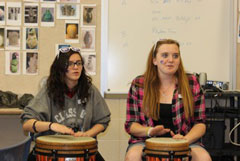April 12, 2016
K-State faculty, future teachers lead STEAM lesson in western Kansas

K-State educators in visual arts, language arts and music traveled to western Kansas to share an integrated science and arts lesson while also providing a multicultural experience.
Faculty from the College of Education's curriculum and instruction department and the College of Arts & Sciences, along with several of their students spent April 1 in Syracuse, providing an integrated lesson at Syracuse Junior-Senior High School. The faculty members included Lou Ann Getz, research associate for rural schools; Todd Goodson, associate professor and department chair of curriculum and instruction; Trina Harlow, art instructor; Vicki Sherbert, assistant professor of curriculum and instruction in English/language arts; and Phil Payne; assistant professor in the School of Music, Theatre and Dance. The pre-service teachers were Elizabeth Hix, Marie Taylor, Jonathan Atteberry, Shannon Miller, Chi Dougherty, Muneera Alonazi and Dana Bruna.
"Our department is excited to provide activities and connections with rural Kansas communities in our service area," Goodson said. "We thought this project would accomplish several goals — support rural schools, provide teaching and leadership opportunities for our own future teachers, while demonstrating that the arts fit nicely into STEM projects. And, as an extra benefit, it's a great recruiting tool as high school students see how passionate our faculty are about teaching."
Under the leadership of K-State faculty and direction by the pre-service teachers, the afternoon's STEAM activities, an acronym for science, technology, engineering, arts and math, were woven together for the high school students. The high school students were introduced to a cajon, a box-like percussion instrument originating in Africa and South America. Payne taught the group an African greeting beat, while Harlow demonstrated how to make the instrument.
The students were divided into three subgroups; the first subgroup painted the cajons with geometric shapes and images representing the instrument's origins. The remaining groups worked together on a "word picture life" about Syracuse, the language arts portion of the project. Sherbert led a brainstorming session for students to identify words and phrases that best described their hometown in terms of music, entertainment, leisure activities and school. Students then used percussion instruments to explore different sounds that represented the descriptors.
Finally, the group established a cadence, keeping the beat with the phrases they had generated, as well as body drumming. The session ended with an "informance," which allowed the students to share with each other the connections made with the numerous components of this project.
Rhonda Levens, Syracuse art teacher, said she believes the students will talk about this experience for a very long time.
"The energy that the students and professors brought to the classroom was awesome," Levens said of K-State's cohort. "Today was a 'memorable moment' for my students, as they will talk about it five, 10 and 20 years from now. I still remember vividly when I was a sophomore in high school and a band from Trinidad performed for our student body. Today was one of those days."
Goodson said the results were amazing as Syracuse and K-State faculty and students alike joined together for a lively example of teaching and learning.
"I'm really pleased we had such a good turnout and that the students and teachers and administrators at the school were so welcoming and energetic regarding this project," Goodson said. "I also appreciate that our faculty were willing to give some of their time and energy to make this happen."
Goodson said the project is part of a growing focus on rural Kansas schools. He plans for this Rural Arts Day to become a regular offering through the department, as faculty members hope to work with more rural schools for similar events.
USD 494 Syracuse is in Hamilton County and is adjacent to the Colorado border. The 24 students who participated in this half-day workshop included a larger number of students enrolled in the visual arts classes. Principal Paul Zuzelski, and Superintendent Ken Bridges helped coordinate and fine tune this experience.
